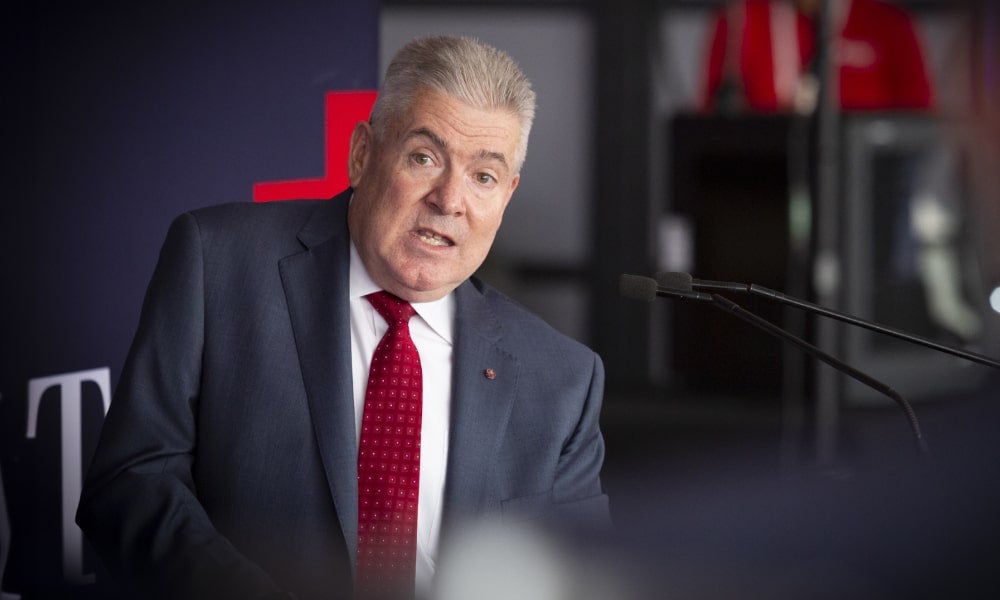Leading through turbulence: navigating disruption and building resilient teams
Stop reacting, start adapting: how leaders can shift from reactive to proactive in turbulent times, embrace a learning mindset, and unlock their team's full potential
Many leaders still struggle to adapt to the unpredictability that has become “business as usual” over the past few years. When faced with new kinds of challenges, it is human nature for leaders to revert to a more reactive approach to managing such challenges. While this can be a good thing in the short-term, it may not be the most positive approach in the long-term – either for an individual or their organisation.
“Human beings are wired to respond to threats, and business leaders have just faced a lot in the past few years,” said Graham Winter, one of Australia’s leading performance psychologists and former Chief Psychologist for three Australian Olympic Teams. “When leaders tend to get reactive, their tempo tends to be driven more by what’s happening to them, rather than how they want to respond. And the trick is to be able to almost turn that around the other way and say, ‘how do we respond to what’s happening, rather than react?”
This point is echoed by Martin Bean, CEO of The Bean Centre and Professor at UNSW Sydney, who together with Mr Winter, recently co-authored Toolkit for Turbulence. The Mindset and Methods That Leaders Need to Turn Adversity to Advantage. On one hand, Mr Bean observed it is “quite seductive” for leaders to stay in reaction mode because it’s focused on the short-term, goals are often clearer and leaders may feel more productive because they’re responding to (and ideally resolving) the issue of the day.
This drive to be reactive has been compounded by multiple issues over the past few years, such as covid (which Mr Bean describes as an accelerant for changes that were already underway). This has led many leaders who might be driven by governance concerns to focus more on security and take a defensive, cautious and fixed approach to managing their organisations and teams. “But what we actually need, when we’re facing turbulence and disruption, is to take a more adaptive mindset which leads into opportunities. This requires more courageous, creative thinking, rather than defensive security thinking,” he said.

Learning from high-performance sports teams
Whether leaders like it or not, Mr Bean said they need the bandwidth and the focus to deal with the here and now and react to whatever they need to. “However, they’ve got to free up X amount of time to be able to devote to the next three horizons of where they want to take their teams, their enterprises, et cetera,” he said.
“In doing so, they need to make learning a habit, so that they’re getting the right information at the right time, even if it’s not 100 per cent perfect – because we don’t have time to wait for perfect. So the book will help teams to snap out of just reacting, and instead focus on rebalancing, reacting and responding. Learning is an important part of this, and leaders need to make sure they’re harvesting the collective brain trust of their team to make decisions. They need a real-time awareness of what’s going on,” he said.
Mr Winter also noted the importance of executives shifting from a reactive mode to leadership and taking time out for learning. He used the analogy of high-performance sports professionals, who share common traits with busy executives and business leaders. With any experienced sports team, he said that one of the most important activities they undertake is learning. Between games, they take regular breaks, learn from previous games through feedback and insights, readjust, realign and then collaborate on how to approach their next game.
“Business teams are not as good as professional sports teams when it comes to learning this way,” said Mr Winter. “A lot of the coaching work I’m doing with teams is just trying to help them and help the leaders to create a psychologically safe environment where people can learn. This is about creating a safe, courageous environment in which leaders can give and receive feedback. Good leaders are putting a lot more emphasis on that now.”

Managing through disruption: a generative AI case study
Generative AI is a timely and very real example of a disruptive change that is challenging many businesses – and why leaders need to take the time to learn about it. “Generative AI is perhaps the best example of disruption that is coming at us at a million miles an hour, that is going to be wickedly unpredictable because it’s going to morph, twist and bend on a daily and weekly basis. I think it’s a great example of why learning has to become a habit for individuals and teams more than ever before,” said Mr Bean, who also served as Vice-Chancellor and President of RMIT University.
If real-time developments aren’t being walked into the executive team (and by default, the strategy and the direction of the organisation) – and instead waiting three, six or 12 months, then it’s probably “game over” for an organisation and its ability to capitalise on opportunities, and avoid the pitfalls, risks or competitive pressure that you will be under as a result of developments in AI,” he said.
As AI speeds up disruption and innovation, teams and individuals have to speed up their ability to align, collaborate and learn. “I think it’s a wonderful, living and present example of why teams need to become adaptive and take that disruption and turn it to advantage in faster learning cycles.”
An important step for leaders who want to utilise AI in their organisation is actually to understand its capabilities, limitations and potential benefits. Mr Winter said the executive leaders he works with express quite distinct opinions about generative AI.
“However, when I ask them about how much time they have taken to learn it, use it, play with it, kick it around – it’s staggering how many of them have these really strong opinions – but have never actually taken the time to use it and play with it,” he said. “When we talk about learning, it is about making sure that the individual and the teams have really brought the expertise into the room and have really taken time to internalise it for themselves before they start making knee-jerk decisions around what they perceive it to be.”
Read more: Steer it – don’t fear it: navigating AI with confidence
Three important steps for executive leaders
In their book, Mr Bean and Mr Winter discuss how leaders can move beyond a reactive approach to disruptions and challenges such as generative AI through a three-step process. “What we found in speaking to many leaders for the book, is that mindset is important. Rather than taking a defensive approach, it’s important to build capability in areas where there might be opportunities to build competitive advantage. So disruption is inevitable, but it’s how they respond to this – so it’s important to adjust the mindset to suit the challenges they’re facing,” said Mr Winter.
Engaging your team is the second important step. In speaking with leaders, it was surprising to see how many struggled to understand the purpose of their leadership team. While many understand divisional responsibilities or what their strategic or business plan might be, Mr Winter explained that it is the role of the leadership team to create the environment in which team members can succeed.
The third step focuses on the role of the leader as a coach. “Being the coach that your people need, means a mix of being able to respond personally while setting the example. It means creating the environment to build the right capabilities to capitalise on opportunities,” he said.
“And in coaching your team, you want to be calm, clear, and confident. Those three things should set the tone for a leaders’ mindset, how their teams operate and how leaders coach that culture themselves.”

Building blocks for successful executive teams
When Mr Bean and Mr Winter started formulating their approach to the book, they said it was designed to provide 25-plus tools to busy leaders who could start working with them straight away. Mr Bean explained that 15 senior executives were interviewed for or contributed to the book about the specific approaches that helped them lead through many forms of business turbulence.
One of the things that stood out to Mr Bean was the focus on values, and the book provides readers with an exercise to help them explore and understand what values are important to them.
“This exercise helps the executive leader of the team do a deep dive into the deeply held core values that drive them to succeed and to be vulnerable and open with the team in sharing those values to help their team understand why they do what they do. They can then connect that to the other members of the team as well as to the enterprise values – using authenticity and vulnerability as a superpower in turbulent times,” he said.
Another tool the book provides readers with is called the “team diamond”, which is designed to assist teams to define their core purpose. “This is not self-evident to most executive teams. While many leaders are good at representing their home team (the team that they’re responsible for), most of them haven’t stopped to ask: ‘Why do we exist?’ Then we take them through a process of discussing and agreeing on four priorities for that team, and how they’re going to measure their success.”
This is followed by another exercise called “the five shares”, which builds on the previous exercises to help establish a more collaborative, high-performing team. “We take people through ways of working together, where they’re able to build trust, confidence, psychological safety, great listening skills, great support levels, and great decision-making capabilities,” said Mr Bean.
Subscribe to BusinessThink for the latest research, analysis and insights from UNSW Business School
Leading through changes to the world of work
While the immediate challenges posed by covid may have passed, Mr Bean affirms that “the dust isn’t going to settle” for leaders. “There isn’t going to be any sort of calm, there’s not going to be a return to normal,” he said.
One of the most important changes that is well underway is in the world of work, which is going to experience continued disruption, according to Mr Bean. “We’re only really at the beginning of a redefinition of what work is, where work is done, the relationship between the individual and the organisation, and how leaders build culture and values in hybrid and distributed workforces. The challenge in that is how do we create meaning for human beings, as it relates to an innate sense of needing to feel productive, valued, and part of a social construct.”
In addition to fundamental changes to the world of work, Mr Winter said leaders are being challenged by new and varied forms of competition. “There is more competition and demand from anywhere and everywhere,” he said. “In government, for example, demand is only going to increase. You’re going to have to make some increasingly tough decisions in health, education and disability, for example. And if you’re in the private sector, you’re going to see people coming from way outside of your industry, who believe they have a solution to a problem in your industry. Their industry might be getting squeezed, and they are looking for opportunities in other sectors. This is asynchronous, nonlinear change: getting used to that is key to operating in the current environment.”
For more information on the Toolkit for Turbulence. The Mindset and Methods That Leaders Need to Turn Adversity to Advantage, please visit the Toolkit for Turbulence website.
